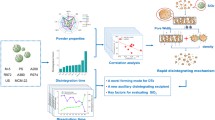Abstract
To explore the effect of particle size on the quality uniformity and in vitro release performance of Strychnos nux-vomica powder, seven samples of Strychnos nux-vomica powder with different particle sizes were prepared. Microstructures and particle sizes were analyzed, and high performance liquid chromatography (HPLC) was used to test the contents and in vitro release performances of brucine and strychnine in the samples. Results showed that the contents and the in vitro release rates of brucine (or strychnine) in different samples were different since there are different proportions of endosperms to epidermal cells in Strychnos nux-vomica powder with different particle sizes. Brucine and strychnine in each sample were promptly released in the first ten minutes and their cumulative release rates were higher than 70% after ten minutes. Eighty minutes later, the cumulative release rate tended to be a constant. Considering the quality uniformity and safety of Strychnos nux-vomica powder used as traditional Chinese medicine, it would be better to control the particle size of Strychnos nux-vomica powder between 100 and 140 mesh in which the maximum cumulative release rate in vitro of brucine and strychnine can be relatively low within this range.
Similar content being viewed by others
References
Abudusalam Abas. Strychnos and its clinical application [J]. Journal of Medicine and Pharmacy of Chinese Minorities, 2006(4): 36 (in Chinese).
Zhu Jianwei, Wu Jibiao, Li Chengshao et al. Strychnos alkali analgesic effect and pharmacodynamic study [J]. China Pharmaceutical Technology, 2005(3): 166–167 (in Chinese).
Yin W, Wang T S, Yin F Z et al. Analgesic and antiinflammatory properties of brucine and brucine N-oxide extracted from seeds of Strychnos nux-vomica [J]. Journal of Ethnopharmacology, 2003, 88(2/3): 205–214.
Chen J, Wang X, Qua Y et al. Analgesic and antiinflammatory activity and pharmacokinetics of alkaloids from seeds of Strychnos nux-vomica after transdermal administration: Effect of changes in alkaloid composition [J]. Journal of Ethnopharmacology, 2012, 139(1): 181–188.
Deng X K, Yin W, Li W D et al. The anti-tumor effects of alkaloids from the seeds of Strychnos nux-vomica on HepG2 cells and its possible mechanism [J]. Journal of Ethnopharmacology, 2006, 106(2): 179–186.
Duddukuri G R, Brahmam A N, Rao D N. Suppressive effect of Strychnos nux-vomica on induction of ovalbuminspecific IgE antibody response in mice[J]. Indian Journal of Biochemistry & Biophysics, 2008, 45(5): 341–344.
Pesce M E, Acevedo X, Bustamante D et al. Progesterone and testosterone modulate the convulsant actions of pentylenetetrazol and strychnine in mice [J]. Pharmacology & Toxicology, 2000, 87(3): 116–119.
Guo Zhenhua, Ma Hongmei, Zhang Boli. Review of pharmacology and toxicology studies and safety on Strychnos and outlook [J]. Journal of Chinese Integrative Medicine, 2008(6): 645–648 (in Chinese).
Cai B C, Wang T, Kurokawa M et al. Cytotoxicities of alkaloids from processed and unprocessed seeds of Strychnos nux-vomica [J]. Acta Pharmacologica Sinica, 1998, 19(5): 425–428.
Cai B C, Hattori M, Namba T. Processing of nux vomica. II. Changes in alkaloid composition of the seeds of Strychnos nux-vomica on traditional drug-processing[J]. Chemical & Pharmaceutical Bulletin, 1990, 38(5): 1295–1298.
Cai B C, Nagasawa T, Kadota S et al. Processing of nux vomica. VII. Antinociceptive effects of crude alkaloids from the processed and unprocessed seeds of Strychnos nux-vomica in mice [J]. Biological and Pharmaceutical Bulletin, 1996, 19(1): 127–131.
Chinese Pharmacopoeia Commission. PRC Pharmacopoeia (2010)[M]. Chinese Medical Science and Technology Press, Beijing, China, 2010 (in Chinese).
Liu Rui, Dai Nasang, Li Jian et al. Effect of different particle size on the dissolubility of main active ingredients puerarin in Redix pueraria [J]. Journal of Traditional Chinese Veterinary Medicine, 2011(1): 40–43 (in Chinese).
Ding Zhiping, Sun Yikun, Qiao Yanjiang. Examination of the in vitro dissolution of berberine in the coptis root powder of different granule diameters [J]. Journal of Beijing University of Traditional Chinese Medicine, 2004(3): 60–62 (in Chinese).
Liu Li, Liu Qiang, Wu Miao et al. Study on powder char acteristics and in vitro dissolution rate of Exocarpium Citri Grandis in different diameters [J]. Journal of Guangdong Pharmaceutical College, 2010(1): 20–22 (in Chinese).
Augsten C, Kiselev M A, Gehrke R et al. A detailed analysis of biodegradable nanospheres by different techniques: A combined approach to detect particle sizes and size distributions [J]. Journal of Pharmaceutical and Biomedical Analysis, 2008, 47(1): 95–102.
Heng P, Chan L W, Easterbrook M G et al. Investigation of the influence of mean HPMC particle size and number of polymer particles on the release of aspirin from swellable hydrophilic matrix tablets [J]. Journal of Controlled Release, 2001, 76(1/2): 39–49.
Mosharraf M, Nystrom C. The effect of particle size and shape and the surface specific dissolution rate of microsized practically insoluble drugs [J]. International Journal of Pharmaceutics (Amsterdam), 1995, 122(1/2): 35–47.
Naik B S, Chakrapani M. A rare case of brucine poisoning complicated by rhabdomyolysis and acute renal failure [J]. The Malaysian Journal of Pathology, 2009, 31(1): 67–69.
Ni L J, Zhang L G. Foundamental Chemometrics and Its Application[M]. East China University of Science and Technology Press, Shanghai, China, 2011 (in Chinese).
Xu Bixue, Zhou Ying, Liang Guangyi et al. The improvement of white peony determination of pre-treatment in the Chinese Pharmacopoeia [J]. Chinese Journal of Pharmaceutical, 2005(21): 83–84 (in Chinese).
Fang Jing, Fu Meihong, Yang Hongjun et al. Determination of microwave-assisted extraction of Chinese Herbs (2): Comparison of determination of imperatorin from Angelica dahurica between microwave-assisted extraction and Chinese Pharmacopoeia method[J]. Chinese Journal of Experimental Traditional Medical Formulae, 2011, 17(20): 89–91 (in Chinese).
Liu L, Wu L P, Liu Q. Pharmaceutical characteristics of Glycyrrhizae, radix micropowder [J]. Journal of Southern Medical University, 2010, 30(5): 1079–1081 (in Chinese).
Author information
Authors and Affiliations
Corresponding author
Additional information
Supported by the Plan Issue of Shanghai Science & Technology Committee (No. 13401901100).
Ni Lijun, born in 1963, female, Prof.
Rights and permissions
About this article
Cite this article
Ni, L., Zhao, W., Zhang, L. et al. Microstructure, content and in vitro release of brucine and strychnine in Strychnos nux-vomica powder with different particle sizes. Trans. Tianjin Univ. 20, 444–450 (2014). https://doi.org/10.1007/s12209-014-2268-9
Accepted:
Published:
Issue Date:
DOI: https://doi.org/10.1007/s12209-014-2268-9




